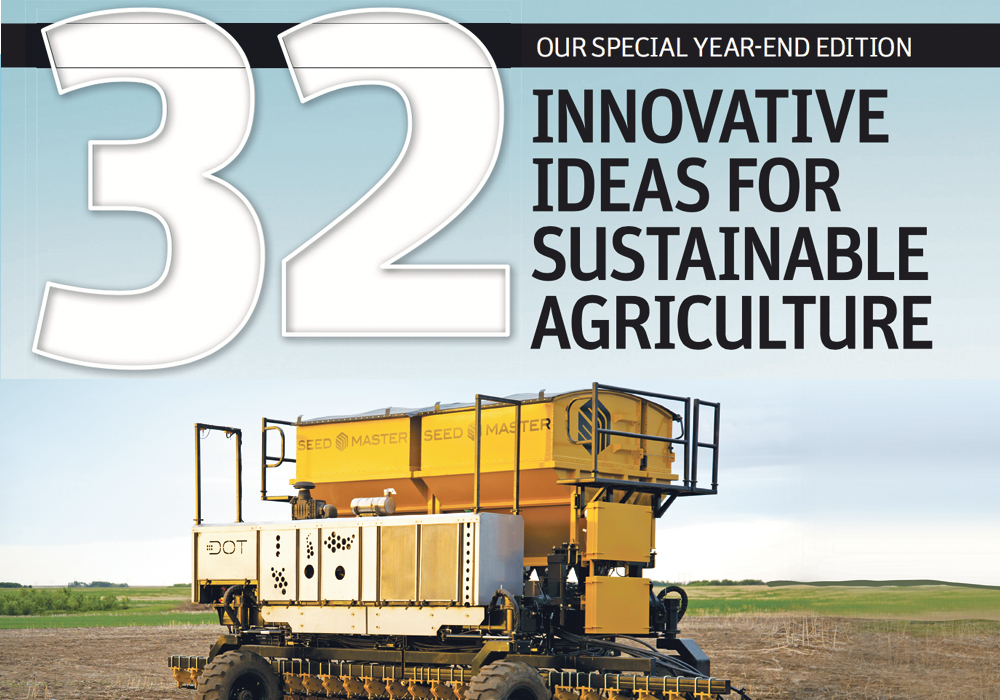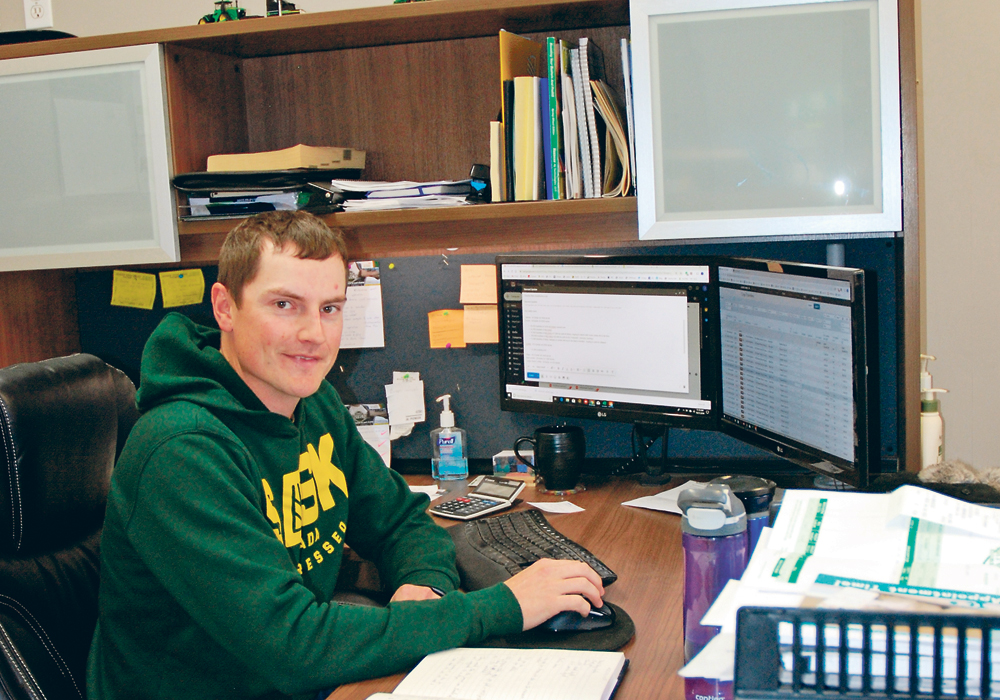What is the future of agriculture? Disruption and chaos. There’s a revolution coming, according to agricultural innovation experts, but it will come with opportunities. By Barb Glen, LETHBRIDGE BUREAU
“Farmers of the future will be innovators,” said Aidan Connolly, chief innovation officer at Alltech, a U.S.-based company with interests in animal nutrition, meat and distilling.
“In the future, my recommendation to farmers would be, buy yourself a passport, go travel the world, read as much as you can, learn as much as you can, and when you see innovations, within reason, embrace them as quickly as possible because I think innovators are the ones that are going to be successful, the ones that are going to survive and thrive.
Read Also

Farming Smarter receives financial boost from Alberta government for potato research
Farming Smarter near Lethbridge got a boost to its research equipment, thanks to the Alberta government’s increase in funding for research associations.
“That’s the farming of the future for me. Innovation.”
Connolly and three other experts discussed the future of farming via a webinar held this fall. The role of consumers, use of so-called big data, autonomous vehicles, nutrigenomics and the attributes of future farmers were part of the conversation.
Other stories in The 2017 Innovation Issue:
- New genetic tools offer way to restore cattle vigour
- Technology can help breed better cattle
- Biotech companies prospecting for microscopic gold mines
- Bee buzzes critical to calculating crop pollination
- Fungus could aid plant growth, reclaim oil sites
- Cracking the megapest genetic code
- Genetic mapping vs. genome sequencing
- French robot prowls the chicken coop so you don’t have to
- New laser technology proves successful for B.C. orchard
- High-tech deterrent devices protect crops from … intruding elephants?
- Diamondback moths focus of Cornell study
- VIDEO: Print your own parts?
- Bees may be serving up humanity’s next big food … and it isn’t honey
- Big doubts about big data
- The little plane that did
- Soil mapping soon to be more usable
- Managing fields could soon move to plant level
- GM pollen: it gets around
- Autonomous vehicles not on the radar for most farmers
- Farm wi-fi connectivity opens new world of possibilities
- Nanotechnology to alter animal health, food systems
- As big data comes to the farm, are policy makers keeping up?
- Farmers not rushing to grab digital tools: survey
- Connecting the DOTs
- Hands-free field test
- Researcher understands farmer doubts about hands-free farming
- The trouble with telematics
- Sensor sensibility
- The discovery that could shake up the beer industry
- Grow your own clothes
- Blockchain technology offers food safety, traceability and more
- Supercluster makes big innovation pitch
- Quicker, cheaper biofuel production in the works
- Alternatives to livestock antibiotics are difficult to assess
Expanded role of consumers
Mary Shelman, former director of the Harvard Business School’s agribusiness program, said farmers of the future will be expected to grow what the market is interested in buying rather than what they prefer to grow and sell.
It sounds obvious, and of course that already occurs to a degree, but Shelman said it’s going to extend to deeper levels.
That is in part due to non-traditional players entering the business. Bill Gates is investing millions in agricultural development. Google is investing in tissue-cultured meat. Jeff Bezos bought Whole Foods with intentions to change traditional food retailing.
“Think about the implications of the supply chain for that, and that differentiation,” said Shelman.
Producers will be increasingly required to differentiate their product and meet specific consumer needs. Technology will help them provide the desired traceability and transparency that consumers increasingly demand, but the economics of doing that aren’t moving in lockstep.
“We need new talent to come in. They can only come in if there’s attractive returns in the sector.”
Shelman emphasized the importance of millennials in shaping the food production system. Those born between 1980 and 2000 are having families and increasing their income. They’re used to getting information in different ways and intent on buying food that reflects their values.
“Food actually reflects their values and this is the thing that perhaps poses the biggest challenge to the traditional food industry, because not only do they want products that meet a certain price point and a certain safety point, they want products that have a purpose. They want products from an industry that has the same values that they do.
“I think it’s putting a very interesting twist on the system right now.”
Big data
The data that can be collected via farm equipment, drones, satellites and other technologies will play a big role in agriculture’s future, the experts agreed.
“You have a tool here to look at millions and billions of observations, whether it’s productivity… the way we grow our crops, how much rain you get, all of this can be integrated into very precise models and that’s going to be the big change in agriculture,” said Karl Dawson, chief science officer at Alltech.
“We’re talking about moving to armchair farming. We’re going to be making our decisions from a site, sitting in front of the computer, looking to see what we can predict in the future. That’s a tremendous tool that we’ve never had before.”
Michael Boehlje of Purdue University says big data can be used not only at the farm level, but by every part of the agricultural production chain. It can allow the sector to trace and evaluate processes as never before.
Autonomous vehicles
They’re already here, said Connolly. Self-driving farm equipment is a logical development in a world where self-driving cars and trucks are already being tested on our roads.
They will also address labour and safety issues, he added.
“I think it is difficult to find labour on farm. When you find labour, you want labour to be well trained and well prepared. You have safety opportunities also. I think there’s just going to be a lot of factors that are going to drive for these autonomously driven tractors and harvesters to become part of our future.”
Boehlje agreed.
“It’s going to be coming much more rapidly than we realize and it has the opportunity to profoundly change the agricultural sector, so it’s a really, really important development.
“My belief is we’ll see this in the fields in five years, not 10 years, and rapidly adopted.”
Nutrigenomics
In simplest terms, nutrigenomics is the study of food nutrients on gene expression in the body that consumes them — “you are what you eat” at the genetic level.
Dawson sees major potential in the technology, which can reveal the effect of food and various ingredients on basic livestock physiology.
“We are starting to narrow in … on the gap between genetic potential and what the animal can do,” he said.
“We have a tool that allows us to actually measure what happens when we make a nutritional change. It’s a very powerful thing.”
He sees a future where animals can be selected for the specific nutrition they can provide, as has long been done in plant breeding.
Through nutrigenomics, producers can potentially measure animal productivity as well as immunity and disease resistance, and alter livestock diets to improve expression of those traits.
He said it could also reduce nutrient needs through more efficient use and lower the effect on the environment.
Who’s your farmer & what does he do?
Farmer demographics are likely to change in coming years, the experts say.
“I think what we’re looking at now is again a fundamental change in what that person’s going to look like,” Connolly said.
“They won’t necessarily grow up on a farm. They might grow up in a city. They won’t necessarily have the skills of maybe understanding animals or understanding plants. They’ll understand data. They’ll understand analytics. They’ll understand equipment. They’ll understand decision making between all of the various technologies of what a person should buy and what they shouldn’t invest in.
“So those are dramatically different skills than we used in the last thousand years, you might say hundred years … to decide who is it that’s a farmer.”
It’s also going to require keen abilities in data management.
“Some farmers abhor record-keeping,” said Boehlje. “We are going to increasingly have to develop that skill and feel comfortable with that skill of looking at numbers, looking at information, trying to understand what they say, the story they tell.”
Besides those attributes, Shelman said the next generation of farmers will have to pay close attention to consumer desires and figure out how to deliver on them.
“It’s not just about producing at the lowest price, but producing what the market wants … and being able to sell into those channels, connect with those channels. So, this is a very big basket now, a very big ask,” she said.
Boehlje also said farmers will have to forego their desire to be completely independent, and instead forge relationships with others in the supply chain.
Connolly summarized it thus: “If anybody thinks that agriculture is going to be the same way in 20 or 30 years’ time, they’ve got their head in the sand.”


















